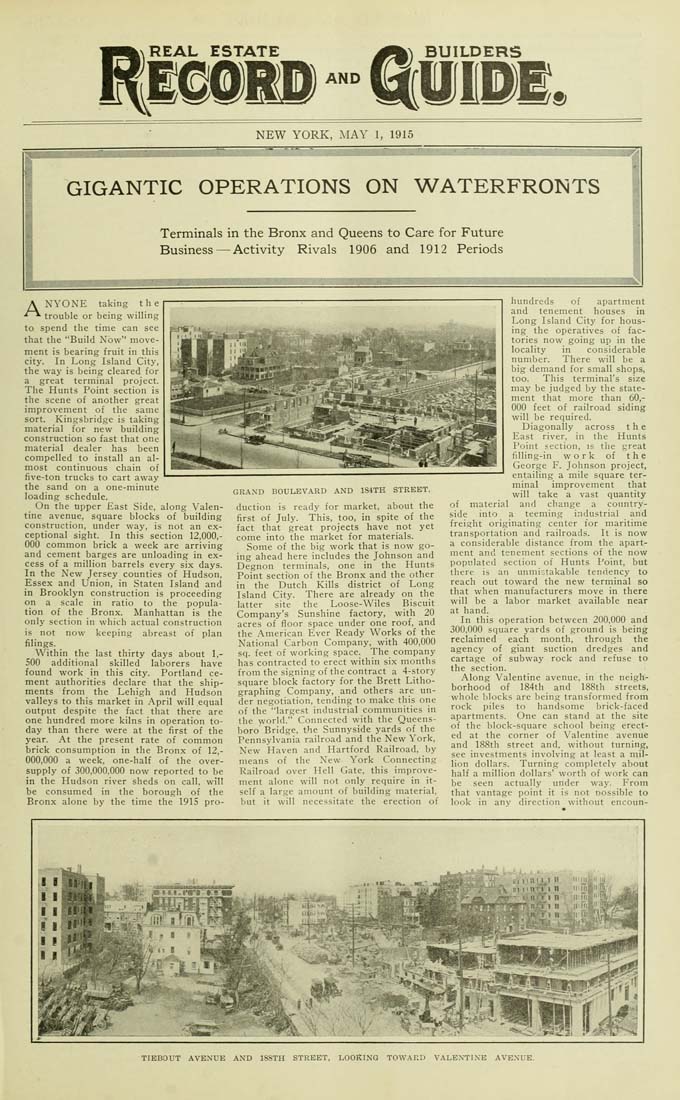Columbia University Libraries Digital Collections: The Real Estate Record
Use your browser's Print function to print these pages.
Real estate record and builders' guide: [v. 95, no. 2459: Articles]: May 1, 1915

Text version:
Please note: this text may be incomplete. For more information about this OCR, view About OCR text.
REAL ESTATE AND BUILDERS lUPE NEW YORK, -MAY 1, 1915 r I L ___ MiiiMigiiiiiiiiiMiiia!Miiii;iimiiiy2 GIGANTIC OPERATIONS ON WATERFRONTS I ■ Terminals in the Bronx and Queens to Care for Future Business — Activity Rivals 1906 and 1912 Periods A NYONE taking the **■ trouble or being willing to spend the time can see that the "Build Now" move¬ ment is bearing fruit in this city. In Long Island City, the way is being cleared for a great terminal project. The Hunts Point section is the scene of another great improvement of the same sort. Kingsbridge is taking material for new building construction so fast that one material dealer has been compelled to install an al¬ most continuous chain of five-ton trucks to cart away the sand on a one-minute loading schedule. On the upper East Side, along Valen¬ tine avenue, square blocks of building construction, under way, is not an ex¬ ceptional sight. In this section 12,000,- 000 common brick a week are arriving and cement barges are unloading in ex¬ cess of a million barrels every six days. In the New Jersey counties of Hudson, Essex and Union, in Staten Island and in Brooklyn construction is proceeding on a scale in ratio to the popula¬ tion of the Bronx. Manhattan is the only section in which actual construction is not now keeping alireast of plan filings. Within the last thirty days about l.¬ SOO additional skilled laborers have found work in this city. Portland ce¬ ment authorities declare that the ship¬ ments from the Lehigh and Hudson valleys to this market in April will equal output despite the fact that there are one hundred more kilns in operation to¬ day than there were at the first of the year. At the present rate of common brick consumption in the Bronx of 12,- 000,000 a week, one-half of the over- supply of 300.000.000 now reported to be in the Hudson river sheds on call, will be consumed in the borough of the Bronx alone by the time the 1915 pro- GRAXD BOULEVARD AND 1S4TH STREET. duction is ready for market, about the first of July. This, too, in spite of the fact that great projects have not yet come into the market for materials. Some of the big work that is now go¬ ing ahead here includes the Johnson and Degnon terminals, one in the Hunts Point section of the Bronx and the other in the Dutch Kills district of Long Island City. There are already on the latter site the Loose-Wiles Biscuit Company's Sunshine factory, with 20 acres of floor space under one roof, and the American Ever Ready Works of the National Carbon Company, with 400.000 sq. feet of working space. The company has contracted to erect within six months from the signing of the contract a 4-story square block factory for the Brett Litho¬ graphing Company, and others are un¬ der negotiation, tending to make this one of the "largest industrial communities in the world." Connected with the Queens¬ boro Bridge, the Sunnyside yards of the Pennsylvania railroad and the New York, New Haven and Hartford Railroad, by means of the New York Connecting Railroad over Hell Gate, this improve¬ ment alone will not only require in it¬ self a large amount of building material, but it will necessitate the erection of hundreds of apartment and tenement houses in Long Island City for hous¬ ing the operatives of fac¬ tories now going up in the locality in considerable number. There will be a big demand for small shops, too. This terminal's size may be judged by the state¬ ment that more than 60,- 000 feet of railroad siding will be required. Diagonally across the East river, in the Hunts Point section, is the great filling-in work of the George F. Johnson project, entailing a mile square ter¬ minal improvement that will take a vast quantity of material and change a country¬ side into a teeming industrial and freight originating center for maritime transportation and railroads. It is now a considerable distance from the apart¬ ment and tenement sections of the now populated section of Hunts Point, but there is an unmistakable tendency to reach out toward the new terminal so that when manufacturers move in there will be a labor market available near at hand. In this operation between 200.000 and 300.000 square yards of ground is being reclaimed each month, through the agency of giant suction dredges and cartage of subway rock and refuse to the section. Along Valentine avenue, in the neigh¬ borhood of 184th and 188th streets, whole blocks are being transformed from rock piles to handsome brick-faced apartments. One can stand at the site of the block-square school being erect¬ ed at the corner of Valentine avenue and 188th street and. without turning, see investments involving at least a mil¬ lion dollars. Turning completelv about half a million dollars' worth of work can be seen actually tinder way. From that vantage point it is not nossible to look in any direction without encoun- TIEBOUT AVENUE AND ISSTH STREET, LOOKING TOWARD VALENTINE AVENUE.